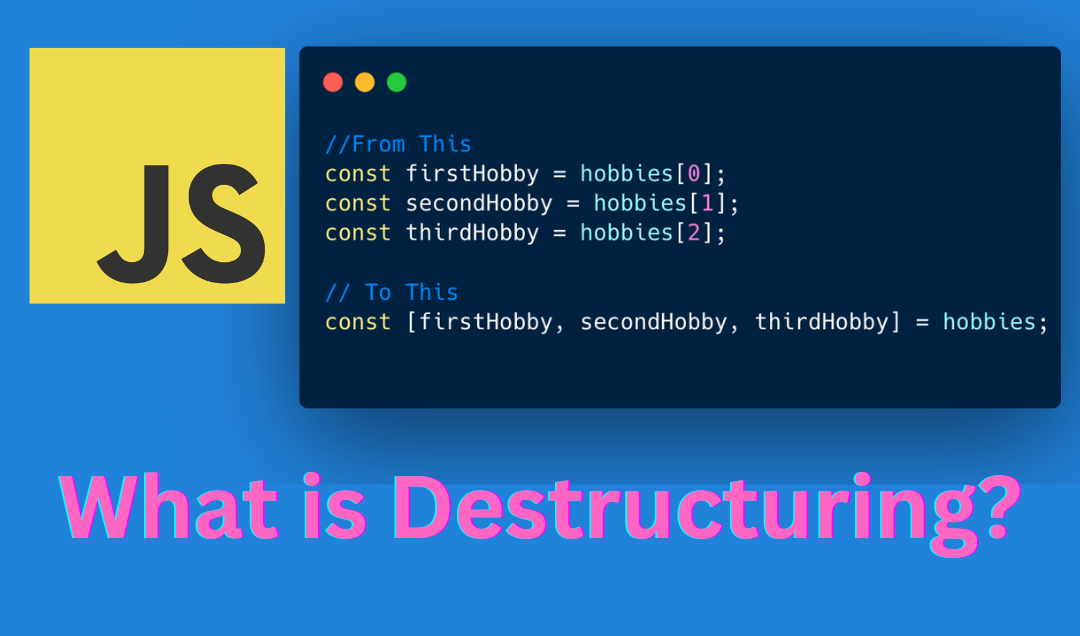Destructuring is a powerful JavaScript feature introduced in ES6 (ECMAScript 2015). It makes it easier to extract values from arrays or properties from objects and assign them to variables in a readable way.
Let's delve into how destructuring works and explore various use cases with examples.
You can get the source code from here.
Table of Contents
What is Destructuring?
Destructuring is a technique that allows you to unpack values from arrays or objects into separate variables.
This process involves breaking down complex data structures into simpler parts, making it easier to work with them.
Array Destructuring
Let's start with array destructuring. We'll use the following example.
Without destructuring, extracting values from an array can be verbose:
const hobbies = ["Reading", "Coding", "Hiking"];
const firstHobby = hobbies[0];
const secondHobby = hobbies[1];
const thirdHobby = hobbies[2];
console.log(firstHobby); // Output: Reading
console.log(secondHobby); // Output: Coding
console.log(thirdHobby); // Output: Hiking
Here, you're accessing each element of the hobbies array using index notation and assigning them to individual variables.
Destructuring simplifies this process into a single line of code, like this:
const hobbies = ["Reading", "Coding", "Hiking"];
const [firstHobby, secondHobby, thirdHobby] = hobbies;
console.log(firstHobby); // Output: Reading
console.log(secondHobby); // Output: Coding
console.log(thirdHobby); // Output: Hiking
In this example, you're extracting the values from the hobbies array and assigning them to variables firstHobby, secondHobby, and thirdHobby, respectively.
Skipping Elements from the Array
You can choose to ignore certain elements by omitting them from the destructuring pattern:
const hobbies = ["Reading", "Coding", "Hiking"];
const [firstHobby, , thirdHobby] = hobbies;
console.log(firstHobby); // Output: Reading
console.log(thirdHobby); // Output: Hiking
In this example, you're destructuring the hobbies array but only assigning values to the firstHobby and thirdHobby variables. You're skipping the second element in the array by placing a comma without a variable name between firstHobby and thirdHobby. This allows you to extract specific elements from the array while ignoring others, providing more flexibility and control in your destructuring patterns.
Nested Array Destructuring
Array destructuring can also be nested. Here's an example:
const nestedArray = [1, [2, 3], 4];
const [firstValue, [secondValue, thirdValue], fourthValue] = nestedArray;
console.log(firstValue); // Output: 1
console.log(secondValue); // Output: 2
console.log(thirdValue); // Output: 3
console.log(fourthValue); // Output: 4
In this code, we have a nested array nestedArray. Using nested array destructuring, you're extracting values from both the outer and inner arrays and assigning them to variables firstValue, secondValue, thirdValue, and fourthValue.
Object Destructuring
Moving on to object destructuring, consider the following object:
const person = {
name: "John Doe",
age: 30,
city: "New York",
occupation: "Software Engineer",
hobbies: ["Reading", "Coding", "Hiking"]
};
Regular Destructuring
Object destructuring allows you to extract properties from objects:
const { name, age, city } = person;
console.log(name); // Output: John Doe
console.log(age); // Output: 30
console.log(city); // Output: New York
In this example, { name, age, city } is the destructuring syntax. It means you're extracting the name, age, and city properties from the person object and assigning them to variables of the same name. So name will have the value "John Doe", age will have 30, and city will have "New York".
Destructuring with Different Names
You can assign extracted properties to variables with different names:
const { name: personName, age: personAge, city: personCity } = person;
console.log(personName); // Output: John Doe
console.log(personAge); // Output: 30
console.log(personCity); // Output: New York
In this example, you're using a syntax like { name: personName, age: personAge, city: personCity } which allows you to assign extracted properties to variables with different names. Here, name from the person object is assigned to personName, age is assigned to personAge, and city is assigned to personCity.
Having Default Values while Destructuring
You can also provide default values for object properties:
const { name, age, gender = "Unknown" } = person;
console.log(gender); // Output: Unknown
Here, you're providing a default value "Unknown" for the gender property in case it's not present in the person object. If gender is not defined in person, the variable gender will default to "Unknown".
Nested Objects
Object destructuring supports nested objects:
const { name, address: { city, country } } = person;
console.log(city); // Output: New York
console.log(country); // Output: undefined (assuming address does not have a country property)
In this example, { name, address: { city, country } } is the destructuring syntax. You're extracting the name property directly from the person object. Then within the address object, you're extracting the city and country properties. So city will have the value "New York", and country will default to undefined assuming address does not have a country property.
Conclusion
That's it! You should now have a good understanding of how JavaScript destructuring works for arrays and objects.
Feel free to experiment with the code examples to further solidify your understanding. If you have any feedback or questions, please contact me on Twitter or Linkedin. Happy learning!

